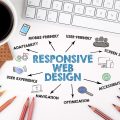Website Design That Converts: Tips for Creating High-Performing Websites
Your website is the digital storefront of your business. Whether you sell products, offer services, or generate leads, your website design plays a crucial role in determining whether visitors take action or leave. A well-crafted website doesn’t just look good—it functions as a conversion machine, guiding users effortlessly toward making a purchase, filling out a form, or engaging with your brand.
A great website isn’t just about aesthetics; it must be optimized for performance, user experience, and conversions. This optimization requires speed, navigation, trust signals, and compelling content that keeps visitors engaged. A poorly designed website can cost you potential customers and revenue, while a well-optimized one can significantly boost your bottom line.
In this article, we’ll explore the key elements of a high-performing website and share actionable tips to help you improve conversions. Whether you’re starting from scratch or revamping your existing site, these insights will ensure your website works as hard as you do.
Understanding Website Conversion
A website conversion occurs when a visitor completes a desired action, such as signing up for a newsletter, making a purchase, or requesting a consultation. Your website design directly influences conversion rates by shaping user experience, engagement, and trust. Poor navigation, slow load times, and unclear messaging can drive users away, while an optimized, visually appealing site encourages them to stay and take action.
To measure your website’s success, consider key performance indicators (KPIs) such as bounce rate, average session duration, and conversion rate. If visitors are leaving quickly without interacting, it’s a sign that your website needs improvements. By making strategic design changes and optimizing for conversions, you can turn more visitors into paying customers.
User-Centered Design Principles
The best web development strategies focus on user experience (UX). If your site isn’t intuitive, users will bounce before they even have a chance to convert. Keep these principles in mind:
- Easy Navigation: Users should find what they need quickly and effortlessly. A clean menu structure and logical page hierarchy improve usability. Consider adding a sticky navigation bar so users can access important links no matter where they are on the page.
- Mobile Responsiveness: With over half of web traffic coming from mobile devices, your site must be optimized for smartphones and tablets. Use a responsive design framework to ensure content adapts seamlessly to different screen sizes.
- Fast Load Times: Slow websites kill conversions. Optimize images, leverage caching, and use a reliable hosting service to improve speed. Studies show that even a one-second delay in load time can result in a 7% reduction in conversions.
- Simple, Clean Layout: Cluttered designs confuse visitors. White space, clear typography, and a balanced color scheme create a pleasant browsing experience. Avoid using too many fonts or colors that distract from your core message.
Crafting Compelling Calls-to-Action (CTAs)
Your CTA buttons guide users toward taking action. Whether it’s “Get Started,” “Request a Quote,” or “Subscribe Now,” your CTAs should be:
- Highly Visible: Use contrasting colors and position them strategically throughout your site. Place CTAs above the fold so they are seen without scrolling.
- Action-Oriented: Phrases like “Claim Your Free Trial” are more engaging than “Submit.” Use strong verbs that encourage immediate action.
- A/B Tested: Experiment with different designs, wording, and placements to see what converts best. Track click-through rates to determine which variations perform the best.
Optimizing for Speed and Performance
Speed is a critical factor in web development. If your site takes longer than three seconds to load, you risk losing potential customers. Here’s how to improve performance:
- Optimize Images: Compress images without sacrificing quality to reduce load times. Use modern formats like WebP for faster loading.
- Enable Browser Caching: Store some data on users’ devices so returning visitors experience faster load speeds. This strategy reduces server requests and improves user experience.
- Minimize Code Bloat: Reduce unnecessary scripts, plugins, and third-party widgets that slow your site. Consider using asynchronous loading for non-essential elements.
- Use a Content Delivery Network (CDN): CDNs use multiple servers to house your content, improving speed and reducing latency. This method is especially useful for global audiences.
The Role of Trust Signals
Users are more likely to convert when they trust your brand. Incorporate trust signals to reassure visitors:
- Social Proof: Display testimonials, reviews, and case studies to showcase happy customers. Highlight any industry awards or recognitions.
- Security Indicators: SSL certificates, security badges, and clear privacy policies make users feel safe. Ensure your checkout process is encrypted and secure.
- Professional Branding: A cohesive look with high-quality visuals and consistent messaging builds credibility. Your brand’s tone and style should be reflected across all pages.
Effective Use of Visuals and Content
A visually engaging website keeps users interested and encourages them to take action. Consider the following:
- High-Quality Images and Videos: Professional visuals create a polished, trustworthy brand image. Use authentic photos rather than generic stock images.
- Scannable Content: Break up text with headings, bullet points, and short paragraphs. Visitors should be able to grasp key information quickly.
- Storytelling: Use compelling copy to connect with visitors emotionally and keep them engaged. Share customer success stories or case studies that demonstrate your value.
SEO and Accessibility Considerations
A beautiful website is useless if no one can find it. Implement SEO best practices to boost visibility:
- Keyword Optimization: Incorporate industry-relevant terms naturally within content.
- Meta Tags and Descriptions: Write compelling titles and descriptions to improve click-through rates. Use schema markup to enhance search results.
- Structured Data Markup: Help search engines understand your content better, improving rankings.
- Accessibility Features: Ensure your site is usable for all visitors by adding alt text to images, providing captions for videos, and using readable fonts. This accessibility also improves SEO and user experience.
Measuring and Improving Performance
Web development doesn’t stop once your site is live. Regular monitoring and updates are essential for maintaining high performance. Key tools include:
- Google Analytics: Track visitor behavior and identify areas for improvement.
- Heatmaps: See where users click and interact most to optimize page elements.
- A/B Testing: Continuously test different designs, CTAs, and layouts to maximize conversions.
- Website Maintenance: Regular updates, security patches, and performance optimizations keep your site running smoothly. An outdated site can lead to security vulnerabilities and poor user experience.
Your website is more than just an online presence—it’s a powerful tool for attracting, engaging, and converting visitors. By focusing on user-centered design, optimizing speed, leveraging trust signals, and continuously refining your approach, you can create a high-performing website that drives real results.
At iwebcontent, we specialize in website design, web development, and website maintenance to help businesses achieve their digital marketing goals. If you’re ready to elevate your online presence, contact us today for a consultation!






